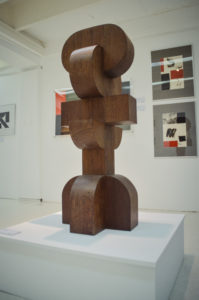NATIONAL Artist for the Visual Arts Arturo Luz gets a retrospective — somewhat — of his 70-year-old art career in #LUZ@90, an exhibit at Ateneo Art Gallery in Katipunan, Quezon City running until April 8.
The exhibit is mounted to mark the artist’s 90th birthday and it consists of 50 paintings, prints, paper and photo collages, and a sculpture from the collection of historian and columnist Ambeth Ocampo, who is as expected the curator of the show.
“The exhibit is a documentation of a long friendship,” Ocampo told the Varsitarian. “Many of his works were usually just given to me so I decided to donate it to the gallery instead for the public to see.”
Born in 1926 in Manila, Luz began painting figurative artworks which was inclined towards linearity and simplicity. For some 20 years beginning 1969, he later on shifted to geometrical figures dipped in abstract expressionism, which puts emphasis on spontaneous, automatic, or subconscious creation.
Arturo briefly studied at the the old UST College of Architecture and Fine Arts. His teachers included Diosdado Lorenzo and Galo Ocampo. He was conferred as National Artist in Visual Arts in 1997.
Luz is known for his linear art and abstract artworks that mostly portray musicians, cyclists, leaves and carnival performers. Abstraction is the process in which concrete objects are portrayed as ideas or concepts.
Luz’s expertise in illustrating lines and figures were shown in “Binondo Houses,” a pen and ink on paper work from the 1950s. Luz illustrated narrow, checkered lines on the roof and irregular shapes and curves that served as windows. It shows a “bahay na bato” abstracted as geometry.
In “Imaginary Landscape,” a 2012 painting on a graphite and acrylic on canvas, Luz rendered monochromatic leaf- and grass-like figures on a red background designed with checkered and triangular patterns.
Luz’s lone sculpture in the exhibit, “Anito,” is made of Philippine hardwood formed with thick chunks of curved blocks intertwined, stressing the sculpture’s elevation.
The exhibit also shows Luz’s collection of photographs such as the “Boxes and Shells,” a series of three photographs that shows ordinary objects in sepia hues.
Ocampo, a longtime friend of Luz, said Luz’s works are at par with modernist works in the West.
“It is (body of) work that speaks to everybody, not just to one particular group,” Ocampo said. “Luz’s works are not rooted to one particular culture, they go beyond nation.”
He received several foreign scholarship grants, including those from Spain in 1953, Italy in 1963, and the United States in 1963. He also joined various exhibitions abroad, including the Philippine Cultural Exhibition held in New York in 1953, Arte de America y España in 1963, the 11th Sao Paolo Biennale in 1971, the Tokyo International Print Biennale in 1974, and the 8th British International Print Biennale in 1984.














